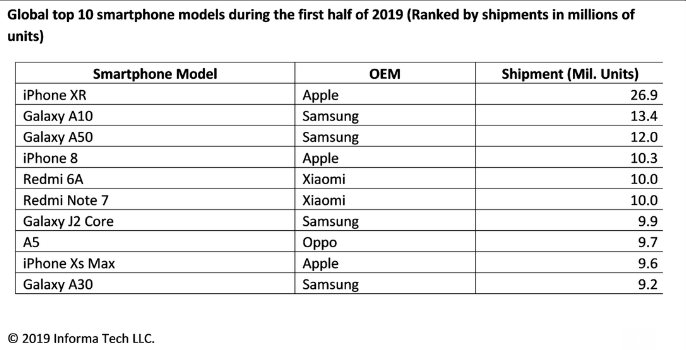After facing drop in iPhone sales after the launch of the iPhone X in 2017, Apple launched an affordable device, the iPhone XR, last year. The move was seen as the company’s way to increase iPhone sales and regain the lost market share. It seems that the Cupertino-based tech firm hit the right chords because market research firm IHS Markit | Technology has claimed that the iPhone XR was the highest shipped smartphone in the first half of 2019. According to IHS Markit’s Smartphone Model Market Tracker report, Apple shipped 26.9 million iPhone XR units worldwide.
A total of 13.6 million iPhone XRs were shipped in the first quarter, and the company shipped 13.3 million units in the second quarter. This is twice as many iPhone XR phones during the first half than the second most popular smartphone model, the Samsung’s Galaxy A10. Samsung shipped a total of 13.4 million units during the same six-month period. Samsung’s Galaxy A50, iPhone 8, and Redmi Note 7 complete the top 5 with 12 million, 10.3 million and 10 million unit shipments respectively.

‘Compared to the Android-based smartphone makers, Apple maintains a relatively small model lineup. This means that Apple’s total sales volume is divided among fewer models. As a result, each of Apple’s iPhone models tends to generate higher shipment numbers than comparable Android smartphones, such as those sold by Samsung,’ Jusy Hong, research and analysis director at IHS Markit | Technology, said in a statement.
Earlier this year, Apple slashed the prices of the iPhone XR which might have boosted the sales of the device. The handset was launched at a starting price of Rs 76,900 (64GB) last year, and it was available for Rs 58,900 after getting a discount of Rs 17,900. The iPhone XR (128GB) could be purchased for Rs 63,999 from its launch price of Rs 81,900.
On Samsung’s performance, Hong said that the absence of its latest flagships from the top 10 list represents a significant challenge for the company. “However, increased shipments in the Galaxy A-series indicate Samsung was successful in its change of strategy near the end of 2018, when the company began to rethink how new technologies should be introduced into its overall device portfolio,” Hong noted.
